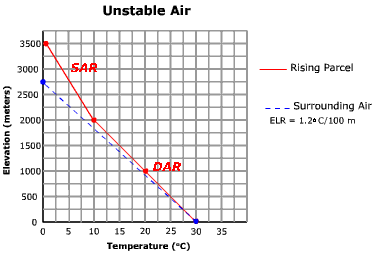|
Atmospheric
Moisture
Adiabatic temperature change is an important factor in determining the
stability of the air. We can think of air stability as the tendency for air to rise
or
fall through the atmosphere under its own "power". Stable air has a tendency to
resist movement. On the other hand, unstable air will easily rise. What gives air
"power" to rise? The tendency for air to rise or fall depends on the adiabatic
and environmental lapse rates.
Figure 7.12
Stable Atmospheric Conditions
Stable atmospheric conditions prevail when the
environmental lapse rate is less than the saturated adiabatic rate. An
example of this condition is shown in Figure 7.12. At the surface (0
meters) both the parcel of air (red line) and the air of the surrounding
environment (blue line) have the same temperature. The surrounding air is
changing its temperature at a rate of .65oC/100 meters. The parcel on this
day is "dry" and will rise and cool at a temperature
of 1oC/100 meters. After giving the parcel a slight upward push, it rises to
a level of 1000 meters where it cools to a temperature of 20oC. A
measurement of the air surrounding the parcel shows a temperature of
23.5oC. In other words, the parcel is colder (and more dense) than the
surrounding air at 1000 meters. If the uplift mechanism ceased, the
parcel of air would return to the surface.
 Figure 7.13 Unstable Atmospheric Conditions Figure 7.13 Unstable Atmospheric Conditions
Air is unstable when the environmental lapse rate is greater than the dry adiabatic
rate. Under these conditions, a rising parcel of air is warmer and less dense than the air
surrounding it at any given elevation. Figure 7.13 depicts unstable conditions. Follow
up the
graph for the rising parcel of air. Note that at any elevation above the surface
the parcel temperature is higher than the air that surrounds it. Even as it reaches the
dew point temperature at 2000 meters, the air remains warmer than the
surrounding air. As a result it continues to rise and cool at the
saturated adiabatic rate. Vertically developed clouds are likely to develop under unstable
conditions such as this.
Previous |
Continue
|
 CONTENTS | ATLAS | GOOGLE EARTH
CONTENTS | ATLAS | GOOGLE EARTH